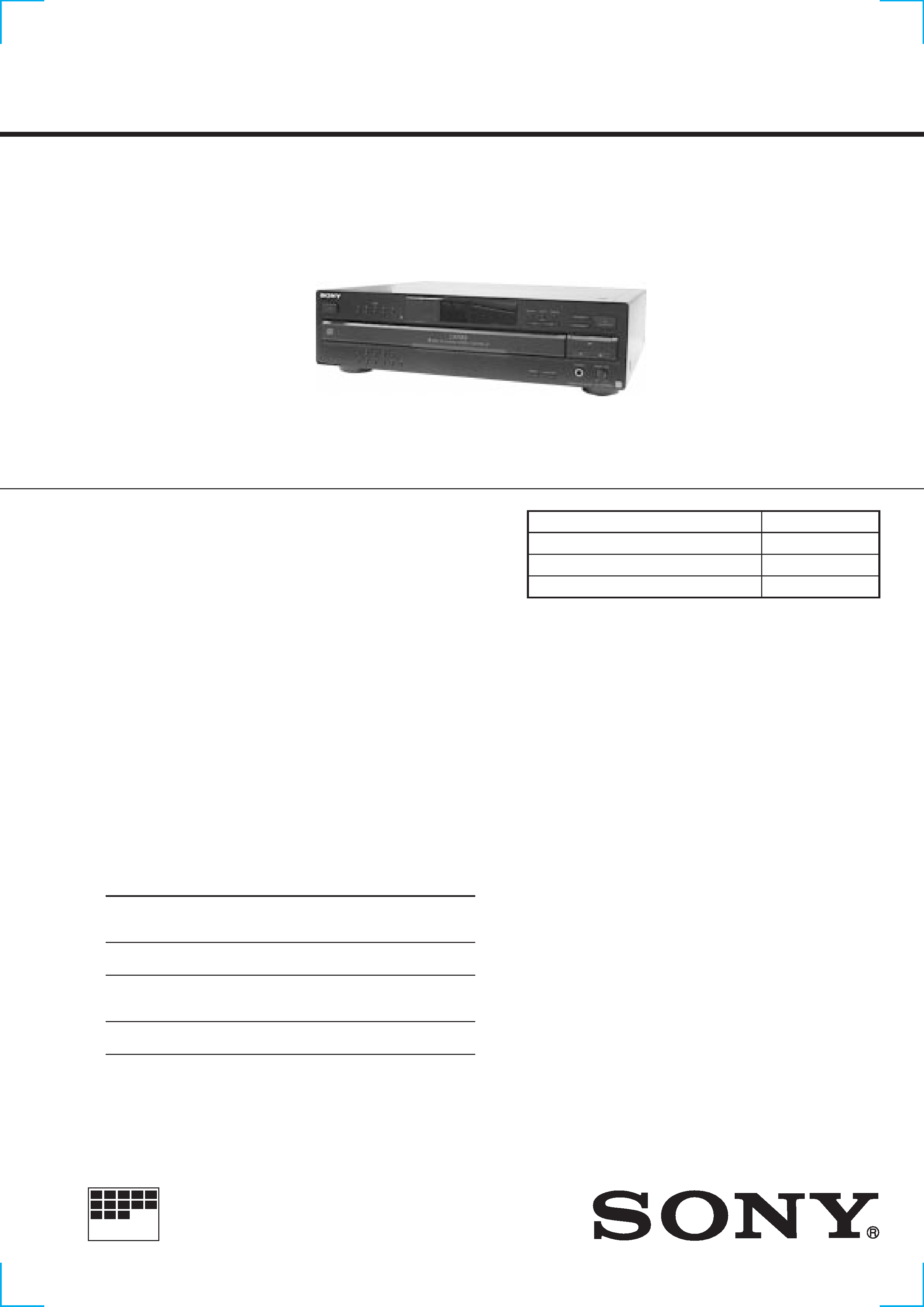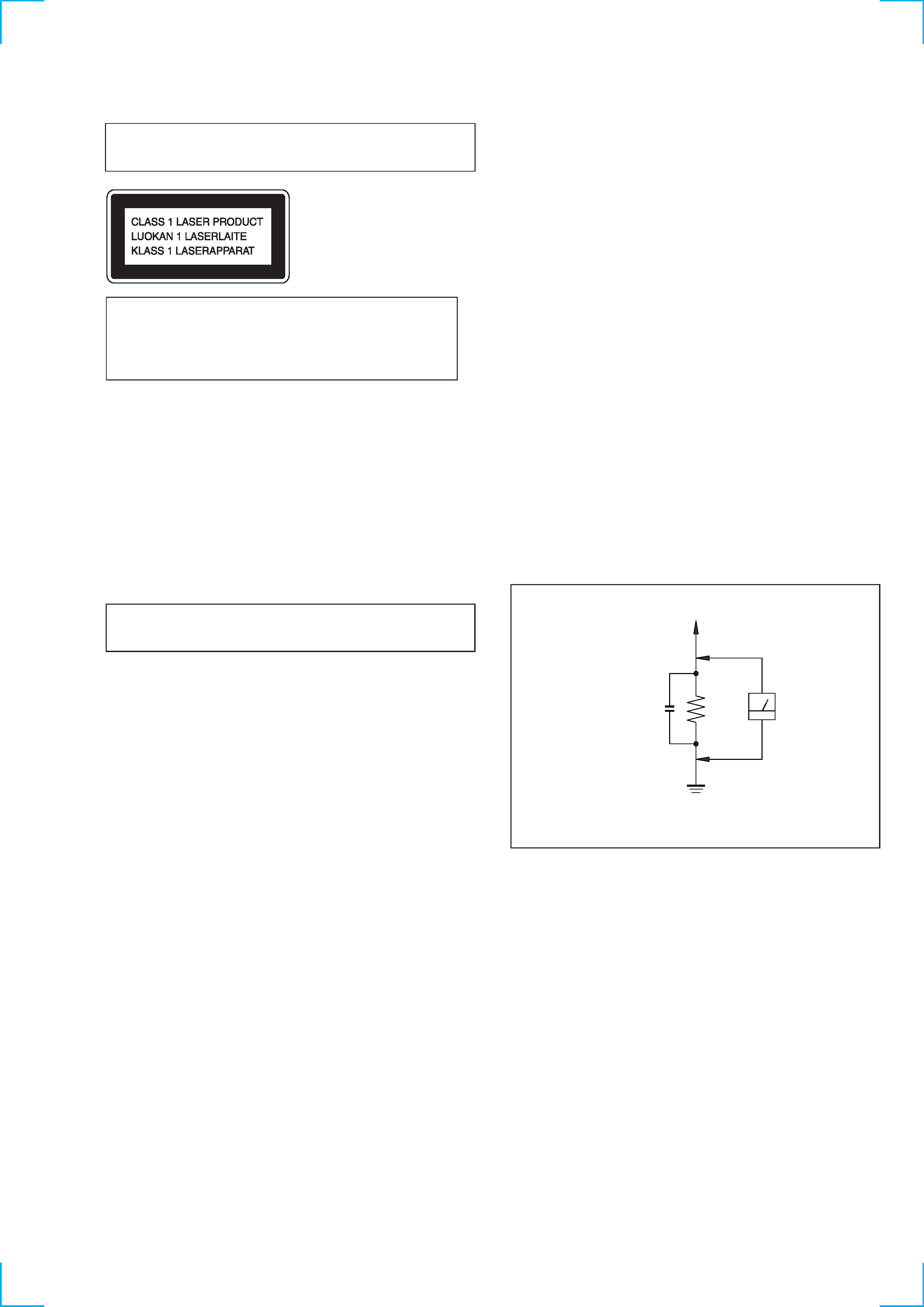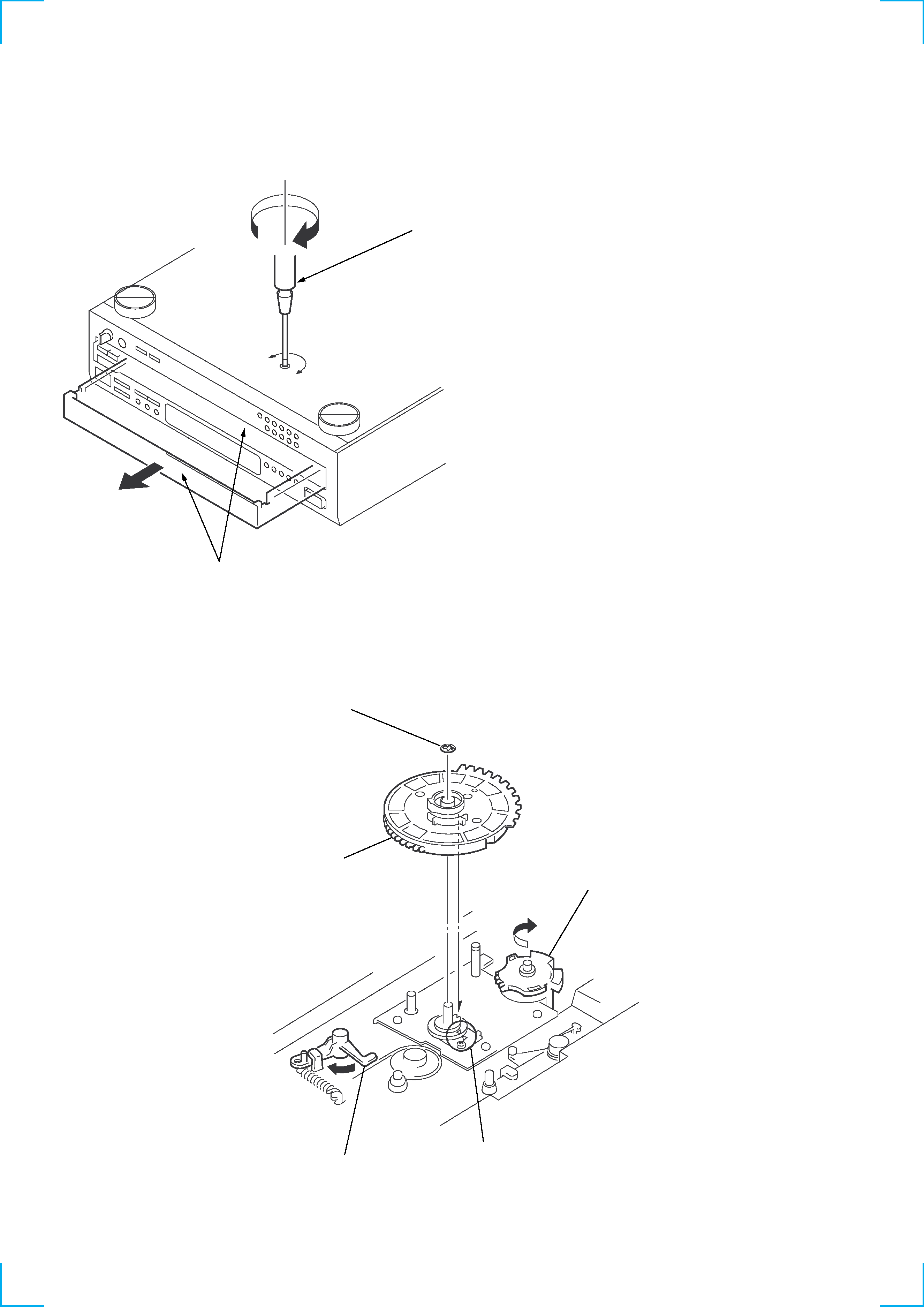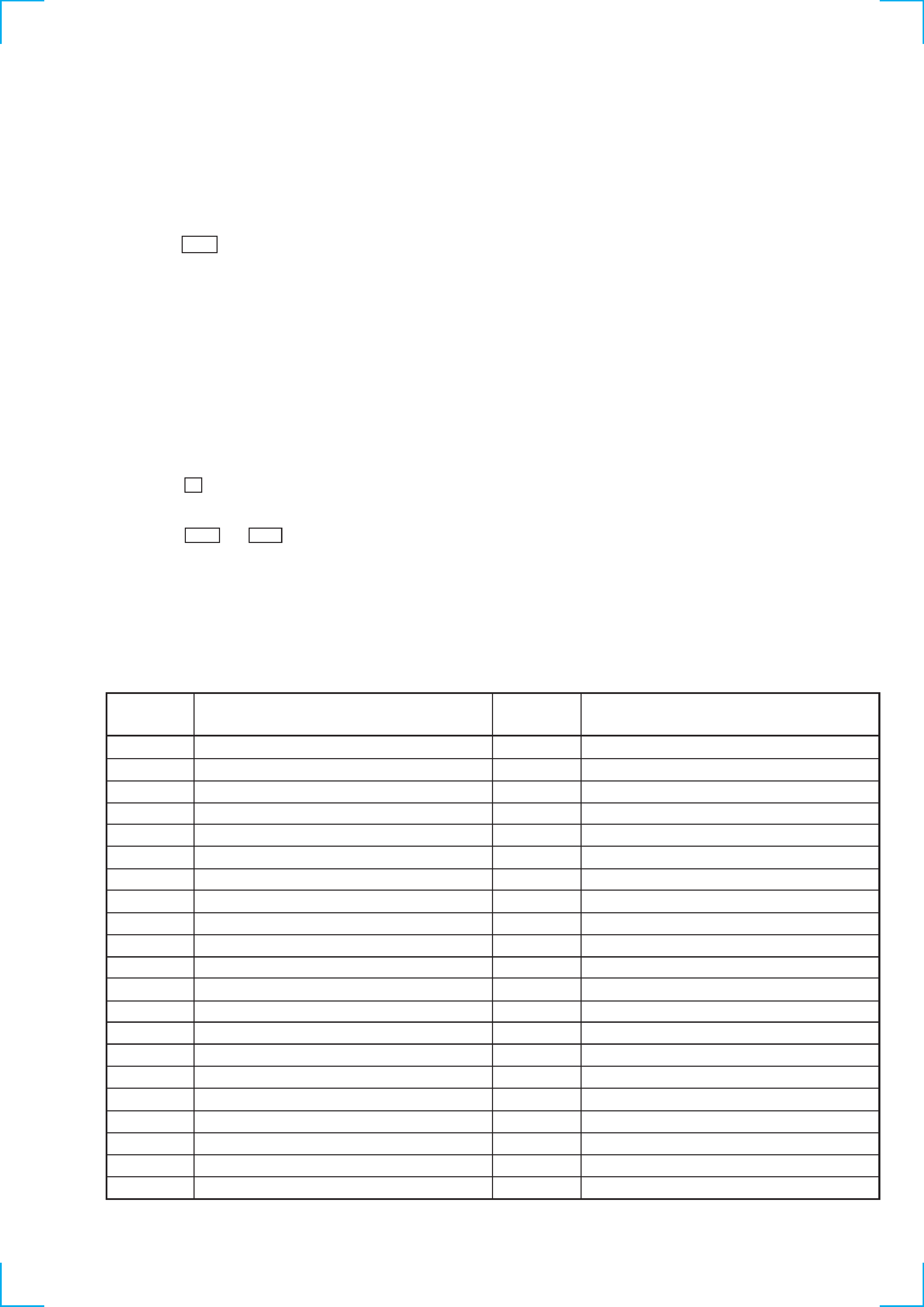
CDP-CA70ES
US Model
Canadian Model
SERVICE MANUAL
COMPACT DISC PLAYER
MICROFILM
Manufactured under license from Dolby Laboratories
Licensing Corporation.
"DOLBY" and the double-D symbol
aare trademarks
of Dolby Laboratories Licensing Corporation.
SPECIFICATIONS
Model Name Using Similar Mechanism
NEW
CD Mechanism Type
CDM27I
Base Unit Name
BU-5BD25
Optical Pick-up Name
KSS-213B/S-N
Compact Disc Player
Laser
Semiconductor laser (
= 780 nm)
Emission duration: continuous
Laser output
Max 44.6 µW*
* This output is the value measured at a
distance of 200 mm from the objective
lens surface on the Optical Pick-up
block with 7 mm aperture.
Frequency response
2 Hz to 20 kHz ± 0.3 dB
Signal-to-noise ratio
More than 117 dB
Dynamic range
More than 99 dB
Harmonic distortion
Less than 0.0025%
Channel separation
More than 110 dB
Output
Jack
Maximum
Load
type
output
impedance
level
LINE OUT
Phono
2V
Over 10 k
jacks
(at 50 k
)
DIGITAL OUT
Optical
18 dBm
Wave length:
(OPTICAL)
output
660 nm
connector
PHONES
Stereo
15 mW
32
phone jack
General
Power requirements
120 V AC, 60 Hz
Power consumption
15W
Dimensions (approx.)
430
× 125 × 400 mm
(w/h/d)
(17
× 5 × 15 3/4 in.) incl. projecting parts
Mass (approx.)
6.4 kg (14 lbs 2 oz)
Supplied accessories
Audio cord (2 phono plugs2 phono plugs) (1)
Remote commander (remote) (1)
R6(SIZE AA)batteries (2)
Design and specifications are subject to change without notice.

-- 2 --
TABLE OF CONTENTS
1.
SERVICE NOTE ··························································· 4
2.
GENERAL ······································································ 7
3.
DISASSEMBLY
3-1.
Front Panel ········································································· 9
3-2.
Disc Table Assembly and Disc Table and Press Pulley ······ 9
3-3.
Main Board ······································································· 10
3-4.
CDM Assembly ································································ 10
3-5.
Optical Pick-up Block Assembly ····································· 11
3-6.
Bracket (Gear) Assembly ················································· 11
4.
TEST MODE ································································ 12
5.
ELECTRICAL BLOCK CHECKING ···················· 15
6.
DIAGRAMS
6-1.
Circuit Boards Location ··················································· 17
6-2.
Block Diagram ································································· 19
6-3.
Schematic Diagram BD Section ····································· 21
6-4.
Printed Wiring Board BD Section ·································· 23
6-5.
Printed Wiring Board
Main Section ······························ 25
6-6.
Schematic Diagram Main Section (1/2) ························· 27
6-7.
Schematic Diagram Main Section (2/2) ························· 29
6-8.
Schematic Diagram
HP Section ···································· 31
6-9.
Printed Wiring Board
HP Section ·································· 32
6-10. Schematic Diagram Display Section ······························ 33
6-11. Printed Wiring Board Display Section ··························· 35
6-12. IC Block Diagrams ··························································· 37
6-13. IC Pin Functions ······························································· 40
7.
EXPLODED VIEWS
7-1.
Front Panel and Case Section ··········································· 44
7-2.
Back Panel and Disc Table Section ·································· 45
7-3.
Chassis Section ································································· 46
7-4.
Base Unit Section (BU-5BD22) ······································· 47
8.
ELECTRICAL PARTS LIST ··································· 48

-- 3 --
NOTES ON HANDLING THE OPTICAL PICK-UP
BLOCK OR BASE UNIT
The laser diode in the optical pick-up block may suffer electrostatic
breakdown because of the potential difference generated by the
charged electrostatic load, etc. on clothing and the human body.
During repair, pay attention to electrostatic breakdown and also use
the procedure in the printed matter which is included in the repair
parts.
The flexible board is easily damaged and should be handled with
care.
NOTES ON LASER DIODE EMISSION CHECK
The laser beam on this model is concentrated so as to be focused on
the disc reflective surface by the objective lens in the optical pick-
up block. Therefore, when checking the laser diode emission,
observe from more than 30 cm away from the objective lens.
CAUTION
Use of controls or adjustments or performance of procedures
other than those specified herein may result in hazardous
radiation exposure.
Notes on chip component replacement
· Never reuse a disconnected chip component.
· Notice that the minus side of a tantalum capacitor may be
damaged by heat.
Flexible Circuit Board Repairing
· Keep the temperature of soldering iron around 270°C
during repairing.
· Do not touch the soldering iron on the same conductor of the
circuit board (within 3 times).
· Be careful not to apply force on the conductor when soldering
or unsoldering.
Laser component in this product is capable of emitting radiation
exceeding the limit for Class 1.
This appliance is classified as
a CLASS 1 LASER product.
The
CLASS
1
LASER
PRODUCT MARKING is
located on the rear exterior.
SAFETY-RELATED COMPONENT WARNING!!
COMPONENTS IDENTIFIED BY MARK
! OR DOTTED LINE WITH
MARK
! ON THE SCHEMATIC DIAGRAMS AND IN THE PARTS
LIST ARE CRITICAL TO SAFE OPERATION. REPLACE THESE
COMPONENTS WITH SONY PARTS WHOSE PART NUMBERS
APPEAR AS SHOWN IN THIS MANUAL OR IN SUPPLEMENTS
PUBLISHED BY SONY.
ATTENTION AU COMPOSANT AYANT RAPPORT
À LA SÉCURITÉ!
LES COMPOSANTS IDENTIFÉS PAR UNE MARQUE
! SUR LES
DIAGRAMMES SCHÉMATIQUES ET LA LISTE DES PIÈCES SONT
CRITIQUES POUR LA SÉCURITÉ DE FONCTIONNEMENT. NE
REMPLACER CES COMPOSANTS QUE PAR DES PIÈSES SONY
DONT LES NUMÉROS SONT DONNÉS DANS CE MANUEL OU
DANS LES SUPPÉMENTS PUBLIÉS PAR SONY.
SAFETY CHECK-OUT
(US model only)
After correcting the original service problem, perform the
following safety checks before releasing the set to the customer:
Check the antenna terminals, metal trim, "metallized" knobs, screws,
and all other exposed metal parts for AC leakage. Check leakage as
described below.
LEAKAGE
The AC leakage from any exposed metal part to earth ground
and from all exposed metal parts to any exposed metal part having
a return to chassis, must not exceed 0.5 mA (500 microampers).
Leakage current can be measured by any one of three methods.
1.
A commercial leakage tester, such as the Simpson 229 or RCA
WT-540A. Follow the manufacturers' instructions to use these
instruments.
2.
A battery-operated AC milliammeter. The Data Precision 245
digital multimeter is suitable for this job.
3.
Measuring the voltage drop across a resistor by means of a
VOM or battery-operated AC voltmeter. The "limit" indication
is 0.75 V, so analog meters must have an accurate low-voltage
scale. The Simpson 250 and Sanwa SH-63Trd are examples of
a passive VOM that is suitable. Nearly all battery operated
digital multimeters that have a 2V AC range are suitable. (See
Fig. A)
Earth Ground
AC
voltmeter
(0.75V)
1.5k
0.15
µF
Fig. A. Using an AC voltmeter to check AC leakage.
To Exposed Metal
Parts on Set

-- 4 --
SECTION 1
SERVICING NOTE
HOW TO OPEN THE DISC TRAY WHEN POWER
SWITCH TURNS OFF
NOTE FOR MAIN GEAR INSTALLATION
5 Stopper washer (5)
3 Rotate the GEAR (U/D)
to the arrow
A direction.
4 Install the MAIN GEAR
as show in the drawing.
2 Slide the SET LEVER to the
arrow
B direction.
1 Set the mark of
ROTARY ENCODER.
A
B
IN
OUT
Tray
Insert a tapering driver into the aperture of the unit bottom, and turn in
the direction of arrow (to OUT direction).
* To close the disc tray, turn driver in the reverse direction
(to IN direction).

-- 5 --
SHIPMENT MODE
This unit is able to display the test data (character information) written in the CD on its fluorescent indicator tube.
The CD-TEXT TEST DISC (TGCS-313:4-989-366-01) is used for checking the display.
To check, perform the following procedure.
Checking Method:
1.
Turn ON the power, set the disc on the disc table with the side labeled as "test disc" as the right side, close the front cover, and chuck the
disc.
2.
Press the
" button and play back the disc.
3.
The following will be displayed on the fluorescent indicator tube.
Display : 1kHz/0 dB/ L&R
4.
Press the
and ± buttons to switch the track. The text data of each track will be displayed.
For details of the displayed contents for each track, refer to "Table 1 : CD-TEXT TEST DISC TEXT Data Contents" and "Table 2 : CD-
TEXT TEST DISC Recorded Contents and Display".
Restrictions in CD-TEXT Display
In this unit, some special characters will not be displayed properly. These will be displayed as a space or a character resembling it. For details,
refer to "Table 2 : CD-TEXT DISC Recorded Contents and Display".
Table 1 : CD-TEXT TEST DISC TEXT Data Contents (TRACKS No. 1 to 41:Normal Characters)
* Other channel is infinity zero.
NOTE : The contents of Track No. 1 to 41 are the same as those of the current TEST DISC-their titles are displayed.
1
2
3
4
5
6
7
8
9
10
11
12
13
14
15
16
17
18
19
20
21
TRACK
No.
Displayed Contents
22
23
24
25
26
27
28
29
30
31
32
33
34
35
36
37
38
39
40
41
TRACK
No.
Displayed Contents
1kHz/0dB/L&R
20Hz/0dB/L&R
40Hz/0dB/L&R
100Hz/0dB/L&R
200Hz/0dB/L&R
500Hz/0dB/L&R
1kHz/0dB/L&R
5kHz/0dB/L&R
7kHz/0dB/L&R
10kHz/0dB/L&R
16kHz/0dB/L&R
18kHz/0dB/L&R
20kHz/0dB/L&R
1kHz/0dB/L&R
1kHz/-1dB/L&R
1kHz/-3dB/L&R
1kHz/-6dB/L&R
1kHz/-10dB/L&R
1kHz/-20dB/L&R
1kHz/-60dB/L&R
1kHz/-80dB/L&R
1kHz/-90dB/L&R
Infinity Zero w/o emphasis//L&R
Infinity Zero with emphasis//L&R
400Hz+7kHz(4:1)/0dB/L&R
400Hz+7kHz(4:1)/-10dB/L&R
19kHz+20kHz(1:1)/0dB/L&R
19kHz+20kHz(1:1)/-10dB/L&R
100Hz/0dB/L*
1kHz/0dB/L*
10kHz/0dB/L*
20kHz/0dB/L*
100Hz/0dB/R*
1kHz/0dB/R*
10kHz/0dB/R*
20kHz/0dB/R*
100Hz Squer Wave//L&R
1kHz Squer Wave//L&R
1kHz w/emphasis/-0.37dB/L&R
5kHz w/emphasis/-4.53dB/L&R
16kHz w/emphasis/-9.04dB/L&R
CD-TEXT TEST DISC
Performed when returning the unit to the customer.
Custom File Erases all custom files and initializes settings.
Procedure:
1.
Remove the discs from all trays.
2.
While pressing the DISC 2 button and 3 button.
press the
1/u button to turn ON the power.
3.
"NO DISC" is displayed, indicating that the mode has ended.
NOTE: "NO DISC" may be displayed even if there are discs on
the trays.
